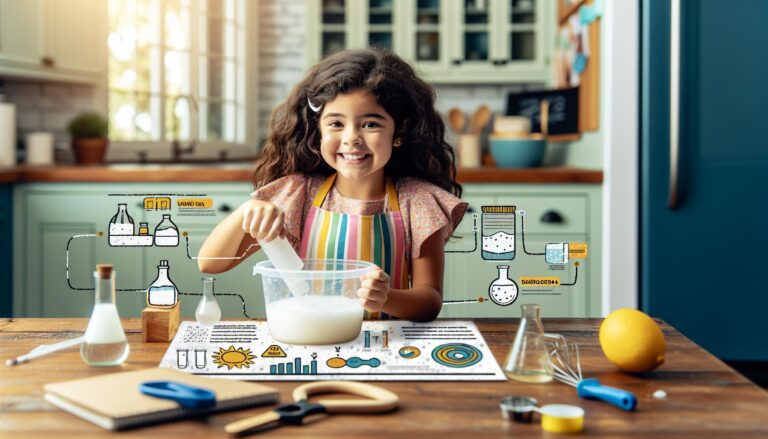
Key Takeaways
- Homeschooling science experiments promote hands-on learning, helping children grasp scientific concepts more effectively while fostering critical thinking and problem-solving skills.
- Parents can tailor experiments to match their child’s interests, pace, and needs, keeping lessons engaging and personalized.
- Simple and affordable experiments often rely on household items, making science accessible without expensive materials or equipment.
- Safety is essential during science activities; using protective gear and clear guidelines ensures a secure and enjoyable experience.
- Fun and interactive experiments, like making volcanoes, studying plant growth, or building balloon rockets, spark curiosity and inspire a lifelong love of science.
- Overcoming challenges like limited resources or time can be managed with creative planning, accessible materials, and breaking larger projects into smaller tasks.
Teaching science at home can feel both exciting and a bit overwhelming. We want to spark curiosity and encourage hands-on learning, but figuring out where to start or how to keep it engaging can be tricky. Science experiments are a fantastic way to bring concepts to life, making learning both fun and memorable for kids of all ages.
Benefits Of Homeschooling Science Experiments
Homeschooling science experiments foster hands-on learning, making abstract concepts tangible. By combining theory with practice, children grasp scientific principles more effectively. Activities like building volcano models or growing crystals spark excitement, transforming learning into an enjoyable process.
These experiments encourage critical thinking and problem-solving. When kids mix ingredients to observe reactions or test variables, they’re developing analytical skills. This practical approach enhances their ability to investigate and draw conclusions.
Parents can customize experiments to match their child’s interests and educational pace. Whether exploring biology with a microscope or physics using simple machines, this flexibility helps maintain engagement. Tailored activities let children learn at a comfortable speed.
Science experiments at home strengthen family bonds. By working together, parents and children create meaningful experiences. This collaborative learning fosters communication and allows parents to better understand their child’s strengths and challenges.
The ability to perform experiments with household items simplifies preparation and reduces costs. Common items like baking soda, vinegar, and paper towels make it easy to start without purchasing specialized equipment.
Homeschooling creates opportunities for real-time feedback. Observing your child’s progress directly lets you adjust the difficulty and challenge level as needed. This immediacy supports continuous improvement while keeping frustration minimal.
By integrating creativity and exploration into lessons, kids develop a natural curiosity about the world around them. This instills a lifelong interest in science, encouraging future exploration and learning beyond their homeschooling years.
Essential Supplies For Homeschooling Science Experiments

Gathering the right materials simplifies preparation and enhances the success of hands-on science activities. With basic equipment and safety gear, experiments become engaging and safe for children of all ages.
Basic Equipment
Starting with common items, we can conduct many experiments using supplies readily available at home or affordable stores. These basics include measuring tools like rulers and measuring cups, kitchen items like mixing bowls and spoons, and everyday objects such as paper towels and rubber bands.
Adding specialized tools can expand options for experiments. Thermometers, magnifying glasses, and droppers allow us to explore concepts like temperature changes, magnification, and liquid handling. For more advanced work, we might use microscopes, test tubes, and pipettes to study biology and chemistry at a deeper level.
Including blank journals or graph paper helps track observations and results during experiments. Organizing these materials in a dedicated space can save time and bring consistency to the learning process. What tools are currently in your home that you can put to use for science projects?
Safety Gear
Prioritizing safety builds confidence and encourages thorough experimentation. Essential safety gear includes gloves, safety goggles, and aprons. These items protect kids from spills, splashes, or unexpected reactions during experiments.
Proper ventilation may also be important, especially when working with substances like vinegar or baking soda that might release gases. Keeping a basic first aid kit nearby adds an extra layer of preparedness. Emphasizing safety doesn’t have to feel restrictive—it allows children to explore more freely without unnecessary risks.
We can explain safety guidelines clearly to set expectations before starting. For example, we can teach children to avoid touching their face during experiments and to clean up thoroughly afterward. How can we turn these precautions into part of the learning experience, rather than just rules to follow?
Popular Science Experiments For Homeschoolers

Science experiments bring learning to life for homeschoolers, offering hands-on ways to explore key concepts. By incorporating fun activities, we can make science engaging and spark curiosity in young minds.
Chemistry Experiments
Simple chemistry experiments teach foundational principles. Creating a baking soda and vinegar volcano demonstrates chemical reactions. Mixing various liquids, like oil and water, illustrates density differences. Conducting pH tests using items like lemon juice and baking soda connects to real-life applications. Using easy-to-access supplies, we can show children the importance of observation and prediction in science.
Physics Projects
Physics projects reveal everyday phenomena through interactive learning. Making a balloon rocket explores propulsion and Newton’s Third Law. Building a simple pendulum highlights concepts of potential and kinetic energy. Experimenting with magnetism using household magnets introduces magnetic fields and forces. Hands-on projects help explain these principles, making them relatable for students.
Biology Activities
Biology activities connect children to the natural world. Observing plant growth by sprouting seeds teaches about photosynthesis and life cycles. Examining celery in colored water illustrates how plants absorb nutrients. Creating a model of the respiratory system using balloons and straws explains human anatomy in a visual manner. Encouraging children to record observations helps build analytical skills while nurturing scientific curiosity.
Tips For Success With Homeschooling Science Experiments
Homeschool science experiments can be rewarding when approached with preparation and creativity. By setting up a supportive environment, we can help foster enthusiasm and deeper learning for our children.
Creating A Dedicated Space
Organizing a specific area for science activities creates consistency and minimizes distractions. Use a table or countertop that has enough space for materials, making it easier to set up and clean after experiments.
Label bins or containers for commonly used supplies like baking soda, food coloring, and pipettes to keep everything organized. If possible, choose a space with access to water and good lighting to simplify cleanup and observation during experiments. What areas in your home inspire focused, hands-on learning?
Encouraging Curiosity And Creativity
Motivate kids to ask questions and come up with their own hypotheses. Pose open-ended questions like, “What do you think will happen if…?” to spark their imaginations and critical thinking.
Allow room for exploration by letting experiments evolve. For example, after creating a vinegar-baking soda volcano, try varying measurements to see how the reaction changes. How can small adjustments encourage your child to think like a scientist?
Celebrate discoveries, even when results differ from expectations, to build confidence and a love of learning through hands-on activities.
Challenges And How To Overcome Them
Homeschooling science experiments offer exciting opportunities but can present challenges that require practical solutions. Understanding and addressing these difficulties help create a smoother and more enjoyable learning experience.
Limited Resources
Finding materials or equipment for experiments may feel overwhelming. Many science activities use basic household items like vinegar, baking soda, or food coloring, making them accessible. For activities requiring specialized tools like microscopes or pH strips, local libraries, educational kits, or online resources can fill the gap. Simplifying experiments to match available supplies still provides hands-on learning without complicating the process.
What items do you already have at home that could spark curiosity? Leveraging creativity in organizing experiments can reduce the need for new purchases while fostering ingenuity. For example, repurpose common objects like plastic bottles for physics projects or natural items like leaves for biology exploration.
Managing Time Effectively
Balancing science activities with other responsibilities may feel challenging. Planning experiments during less busy times simplifies management. Using schedules or timers helps allocate specific periods to science without disrupting other subjects or routines.
How much time can you dedicate to hands-on learning each week? Choosing shorter, impactful experiments, such as testing water absorption or building simple circuits, saves time while delivering valuable lessons. Breaking larger projects into smaller tasks also keeps students engaged while spreading the workload over multiple sessions.
Conclusion
Homeschooling science experiments offer a unique opportunity to combine education with creativity, exploration, and quality family time. By embracing hands-on learning, we can inspire curiosity, build critical thinking skills, and make science an exciting part of our children’s lives. With the right materials, a focus on safety, and a little preparation, we can turn our homes into vibrant learning spaces where science truly comes to life. Let’s continue to nurture a love for discovery that extends far beyond the classroom.
Frequently Asked Questions
What are the benefits of homeschooling science experiments?
Homeschooling science experiments promote hands-on learning, making it easier for children to understand and apply scientific concepts. They combine theory with practice, enhance critical thinking and problem-solving skills, spark curiosity, and provide opportunities for family bonding. Additionally, experiments can be customized to a child’s pace and interests, making learning more engaging and enjoyable.
What materials do I need for homeschooling science experiments?
You’ll need basic supplies like measuring tools, kitchen items, thermometers, and safety gear (e.g., gloves and goggles). Household items often suffice, but specialized tools like microscopes can expand options. Having journals for observations and a well-organized workspace also simplifies experimentation.
Are science experiments at home expensive?
No, many science experiments use common household items, reducing costs. Affordable tools and supplies can be sourced from local stores or educational kits. By repurposing everyday objects creatively, you can keep expenses low while still offering engaging, meaningful experiments.
How can I ensure safety during at-home science experiments?
Use safety gear like gloves and goggles, ensure proper ventilation, and have a first aid kit on hand. Supervise children closely and teach them about safety precautions. Turning safety into a learning activity helps minimize risks while fostering a responsible approach to experiments.
What are some easy science experiments for homeschoolers?
Simple experiments like baking soda and vinegar volcanoes (chemistry), balloon rockets (physics), and observing plant growth (biology) are great options. These activities demonstrate core scientific principles, encourage hands-on learning, and inspire curiosity in children.
How do I keep children interested in science activities?
Encourage curiosity and creativity by allowing children to ask questions and form hypotheses. Tailor experiments to their interests and celebrate their discoveries, even when outcomes differ from expectations. Hands-on activities make learning enjoyable and foster a love for exploration.
What if I have limited time for homeschooling science?
Plan experiments during less busy periods and break larger projects into smaller steps. Prioritize simpler experiments with shorter preparation and setup times, ensuring activities remain manageable and engaging for both parents and children.
How can I overcome limited resources for experiments?
Use common household items creatively to replace specialized tools. Libraries and online educational kits can also offer affordable resources. Planning ahead and organizing materials helps make the most of what you already have, without compromising the quality of experiments.
Can science experiments be adapted for different age groups?
Yes, experiments can be customized to match a child’s age and learning level. Simplify concepts for younger children, while allowing older learners to explore more advanced scientific principles and conduct detailed observations.
How do I organize science activities at home?
Designate a dedicated space for experiments to reduce distractions. Use labeled bins or containers to store supplies and keep a journal for tracking observations. An organized setup supports focus, makes preparation more efficient, and enhances the learning experience.

